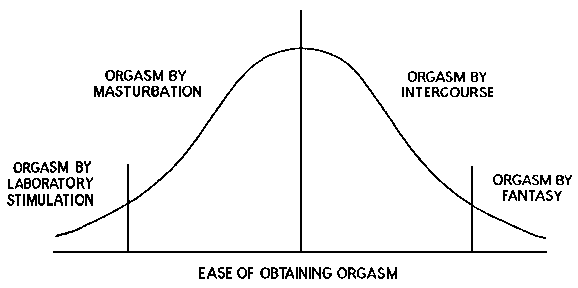
|
The Psychology of SexGlenn Wilson on Female Orgasm as a Luxury |
Why does female orgasm occur at all? The best explanation so far is that of the Californian anthropologist Donald Symons (1979) who suggests that the capacity for orgasm in females stems for the fact that they share with males the basic neurological mechanisms that underlie a capacity which is biologically important only in males. For the sake of simplicity the genetic blueprints for males and females remain as similar as possible without incurring reproductive disadvantage. Thus a female canary has all the mechanisms for singing but does not demonstrate this ability unless injected with male hormone. The human male has vestigial nipples which are quite useless to him and are not erotically sensitive unless he is given oestrogen. A woman’s clitoris is likewise a vestigial penis and, as such, is rather small and not located in such a place that heterosexual intercourse is the optimal method of stimulation. If sufficient clitoral stimulation is given, orgasm will occur, but a great deal of manual or oral attention may be necessary in addition to, or instead of, intercourse if the average woman is to be guaranteed the experience (see Figure, Normal distribution of orgasmic ability in women, from Wilson, 1988).

Impressive confirmation of Symon’s ‘artefact’ theory of female orgasm comes from the discovery that male hormones increase a woman’s sexual responsiveness – although with the risk of masculinizing side-effects like hair on the chin (Kane, Lipton and Ewing, 1969). By contrast, attempts to treat female orgasm difficulty by using anti-anxiety drugs to counter the supposed inhibitions deriving from upbringing and religion have repeatedly failed (Wilson, 1988).
This does not devalue the female orgasm in any way or the efforts made by sex therapists and women’s consciousness groups to help women achieve it. Fingers have not evolved for playing the piano, but many of us can learn to do so and give ourselves and other people a great deal of pleasure in the process. Likewise, many women who have not experienced orgasm can learn the skill and their male partners can be taught to assist. However, it would help enormously if we abandoned the myth that men and women are ‘made for each other’ – that is, constructed in such a way that in the absence of any pathology they will naturally experience simultaneous orgasm during intercourse. Orgasm is natural for men, but for women it is better understood as a skill which can provide a great deal of pleasure to both partners. A full understanding of the differing sexual response cycles of men and women, and the biological basis of this difference, is fundamental to the success of sex therapy.
The resistance of sex problems to social change was seen in the Sun survey described in Chapter 4. In view of the increased frankness of modern society and all the books and articles that have been written about how to improve our sex lives, we might have hoped that the younger generation (people under thirty) would have fewer sexual problems such as guilt and lack of orgasm than their parents’ generation. However, comparisons based on a sample of over four thousand women (Table, from Wilson, 1988) show that these problems persist in almost exactly the same proportions and with just the same difference between men and women.
| Table Sexual difficulties of men and women, under and over thirty years of age | ||||
|
Male
(N=1,862) |
Female
(N=2,905) |
|||
| Age | <30 | >30 | <30 | >30 |
| Impotence | 25 | 29 | 6 | 7 |
| Too quick orgasm | 59 | 53 | 12 | 14 |
| Inabilty to have orgasm | 23 | 23 | 44 | 41 |
| Painful intercourse | 18 | 13 | 45 | 37 |
| Disgust | 5 | 4 | 8 | 9 |
| Guilt | 15 | 13 | 19 | 18 |
| Anxiety/fear | 14 | 14 | 19 | 16 |
| Boredom/lack of interest | 21 | 17 | 35 | 36 |
More than 40 per cent of women, both young and middle-aged, report difficulty in achieving orgasm, and more than half the men in both age-groups complain that their orgasm is often too quick (the reverse of retarded female orgasm). Guilt and anxiety remain as minority problems with both sexes (about 14 per cent of men and 18 per cent of women), but perhaps most striking are the numbers of women who suffer painful intercourse (around 40 per cent) or are simply bored and uninterested in sex (around 35 per cent).
Glenn Wilson, The Great Sex Divide, pp. 90-92. Peter Owen (London) 1989; Scott-Townsend (Washington D.C.) 1992.